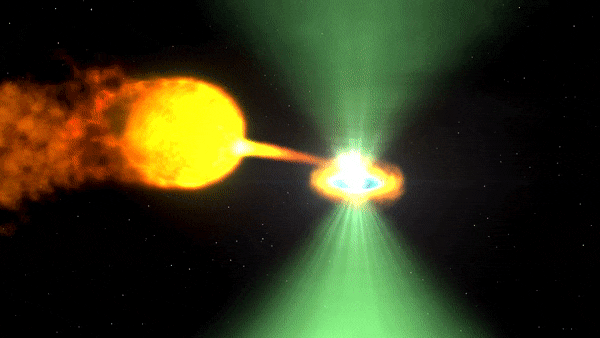
Artist's view of the Earth-orbiting Fermi satellite, illuminated by gamma rays from two distant pulsars. The upper part of the satellite (whitish cube) is the Large Area Telescope (LAT). Crédit, Danielle Futselaar / MPIfR
An international team led by French researchers, including those at DAp, publishes on November 28, 2023 in the Astrophysical Journal a compilation of 340 pulsars seen in gamma rays (30 MeV - 30 GeV) with the LAT space telescope on NASA's Fermi satellite.
Prior to Fermi's launch in 2008, only 11 pulsars were known in gamma rays. This new catalog brings together all the characteristics of all known gamma-ray pulsars. It contains a wealth of information on the mechanisms, poorly understood today, by which pulsar beams are generated. This wealth of centralized information will help theorists explore new avenues in their quest to understand these phenomena.
Astrophysical Journal Supplement 2023, Smith et al, The Third Fermi Large Area Telescope Catalog of Gamma-ray Pulsars
Explore the Fermi Gamma-Ray Pulsar Catalog!
Interactive created by A. David WeigelÉrika SilvaPeter K. G. WilliamsJon Carifio
Powered by AAS WorldWide Telescope
The French contributions to this catalog are numerous and essential:
- DAp researchers provided the spectral characterization of all pulsars, extracted from the general LAT source catalog, and contributed to the estimation of their distances.
- The LLR at Ecole Polytechnique contributed to the optimization of the pulsar signal search;
- many of the radio observations and analyses are carried out by the LPC2E-Orléans team around the large Nançay radio telescope;
- and finally, the LAB and LP2i in Bordeaux centralized and coordinated the effort
The catalog is the result of multiple observations and analyses by a worldwide network of scientists over a period of twenty years:
- a dozen or so radio telescopes constantly monitor thousands of pulsars;
- other radio astronomers search for new radio pulsars in gamma-ray sources discovered by the LAT;
- other researchers have mobilized millions of hours of computer time to find pulsars with no radio counterpart, by searching for a periodicity in the arrival times of gamma-ray photons recorded by the LAT.
What is a pulsar?
At the end of a massive star's life, the sudden transformation of its core into neutrons triggers a supernova explosion, destroying the star and giving birth to a pulsar. A pulsar is a neutron star that rotates rapidly, at up to 700 revolutions per second. Its mass is 1.2 to 2.2 times that of the Sun, but it has a diameter of just 25 km. As the pulsar is strongly magnetized, the rotation of the magnetic field creates an electric field capable of accelerating particles. These particles emit beams of radio radiation and, for the most powerful, gamma rays. Just like a sea lighthouse, we can see pulsations when one of these beams sweeps over the Earth.

The neutron star's rotation period is on the x-axis, and its deceleration rate is on the y-axis.
Black dots are radio pulsars. Colored dots indicate pulsars detected in gamma rays with the Fermi LAT: those in green and red are also seen in radio; those in blue are seen in gamma rays only. At bottom left are the millisecond pulsars. Blue diagonal lines indicate pulsar ages in years, using idealized assumptions. The green diagonals indicate the magnetic field intensity at the pulsar surface, again idealized. The red lines indicate the power available for radiation, deduced from the measured slowdown.
Credit, Fermi-LAT Collaboration.
The complete pulsar catalog
Most of the 3,400 known pulsars (10x more than gamma-ray pulsars) are "seen" in radio waves, and are located in the Milky Way. They are classified according to the power released by their slowdown, which is up to a hundred thousand times the power radiated by our Sun. The 10% of pulsars seen in gamma-ray are all among the 10-15% most powerful.
Gamma-ray pulsars fall into two distinct groups:
- the youngest, a thousand to a million years since the neutron star's supernova birth,
- and the oldest, thousands of times older. Most of these "extreme" pulsars emit gamma rays.
Paradoxically, older pulsars are the fastest-spinning. A low-mass star orbiting a neutron star can accelerate the latter's rotation by transferring matter to it. These millisecond pulsars, or MSPs, spin several hundred times per second - in the figure above, MSPs form the cloud of dots at bottom left. « Before Fermi, we didn't know whether MSPs were visible at high energies", points out Lucas Guillemot, assistant astronomer at LPC2E (Orléans). "In the end, half of our discoveries are MSPs, in a variety of sub-categories that address a range of scientific questions. In addition to their intrinsic interest, pulsars are tools that enable an extraordinary variety of studies".
Jean Ballet of DAp continues, "It's very difficult to find pulses in MSPs without the help of radio. Detected but unknown gamma-ray sources could still conceal hundreds of MSPs!"
Two examples of ancient pulsar applications:
- The mass of neutron stars - A hundred or so gamma-ray MSPs are in a binary system with another star, with fast orbits (hours, or days). For half of these, pulsar radiation evaporates the star before our very eyes - a major discovery in itself. For 7 of these latter systems, the plane of the pulsar-star orbit coincides with the line of sight from Earth, since we see regular eclipses of the pulses by the companion star. Armed with the inclination of orbits, Newtonian mechanics gives masses. Now, the maximum mass of a neutron star depends directly on unknown details of the nuclear force, and these measurements refine our mastery of subatomic physics.
- Very low-frequency (nHz) gravitational waves - Another set of gamma-ray MSPs contrasts with the previous one in its stability. These MSPs are the most precise natural clocks known. Radio astronomers around the world have recently exploited this class of pulsars to measure the average intensity of gravitational waves emitted by pairs of supermassive black holes in the cores of distant galaxies. Our gamma-ray measurements provide useful constraints, and will be able to confirm radio measurements within five years - an important confirmation given the complexity of radio measurements.
Young pulsars are often found in supernova remnants, in complex areas of the Milky Way. They are surrounded by a nebula (which also emits gamma rays) created by their winds of accelerated electrons and positrons. Born of violent explosions, they are turbulent. The pulsar catalog provides an overview of the evolution from the turbulence of youth to the stability of old stars, and of the different stages throughout their lives.
Animation of the gamma-ray pulsar catalog © NASA (27.11.2023)
Contacts DAp: Jean BALLET, Isabelle GRENIER
article: https://iopscience.iop.org/article/10.3847/1538-4357/acee67
other news:
https://www.insu.cnrs.fr/fr/cnrsinfo/catalogue-de-300-pulsars-recoltes-en-rayons-gamma
https://www.aei.mpg.de/1083085/nasa-s-fermi-mission-nets-nearly-300-gamma-ray-pulsars-and-counting
• Structure and evolution of the Universe › High energy cosmic phenomena and astroparticles
• Department of Astrophysics (DAp) // UMR AIM
• High Energy Cosmic Phenomena Research Laboratory
• Fermi




